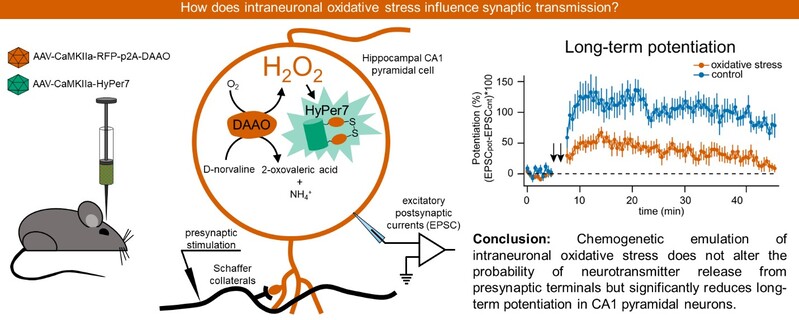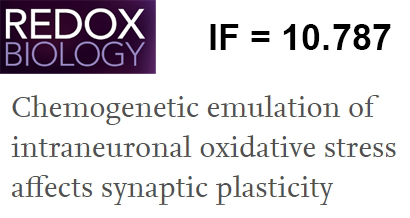Press-room / news / Science news /
Chemogenetic emulation of intraneuronal oxidative stress affects synaptic plasticity
The members of the redox biology group and the Laboratory of molecular technologies from the Department of Metabolism and Redox Biology, IBCH RAS, in the collaboration with colleagues from Federal Center of Brain Research and Neurotechnologies, Federal Medical Biological Agency, and Pirogov Russian National Research Medical University, using a well-established model of long-term potentiation, revealed that neuronal oxidative stress affects synaptic plasticity.

We created adeno- associated viral (AAV) vectors carrying constructs for expression of the yeast D-amino acid oxidase (DAAO) (EC-1.4.3.3) or its inactive mutant DAAO(R285A) with the ultrasensitive ratiometric H2O2 biosensor HyPer7 in neurons. DAAO catalyzes oxidative deamination of D-amino acids with formation of hydrogen peroxide as a byproduct. Cultured neurons were co-transduced with pairs of AAV vectors to express DAAO or DAAO(R285A) with HyPer7. Live imaging revealed that extracellular application of D-norvaline, a D- amino acid, significantly elevated neuronal H2O2 levels in cultured neurons expressing DAAO in a concentration dependent manner, and did not change the fluorescence of HyPer7 in cultured neurons expressing DAAO(R285A). To examine effects of chemogenetically produced H2O2 on synaptic transmission, AAV vectors with either DAAO or DAAO(R285A) were stereotactically injected into the mouse hippocampal CA1 area. In acute brain slices, we induced long-term potentiation (LTP), a phenomenon of long-term elevation of excitatory postsynaptic currents after a specific pattern of presynaptic stimulation. LTP in pyramidal cells of the hippocampal CA1 area is considered as a form of memory at cellular level. In these experiments, it was demonstrated that treatment of slices with D- norvaline or delivery of D-norvaline into a single neuron through a patch pipette enable the LTP induction, but with lower amplitudes of excitatory post synaptic currents, which rapidly reduced to basal levels. Our observations show that intraneuronal oxidative stress affects memory formation. This can underlie aging-related cognitive deficit prior to the onset of evident neurodegeneration. A combination of the DAAO-based chemogenetic tool with electrophysiological recordings represents a powerful approach for screening potential neuroprotective drugs.
The work is published in the Redox Biology.
january 16, 2023


